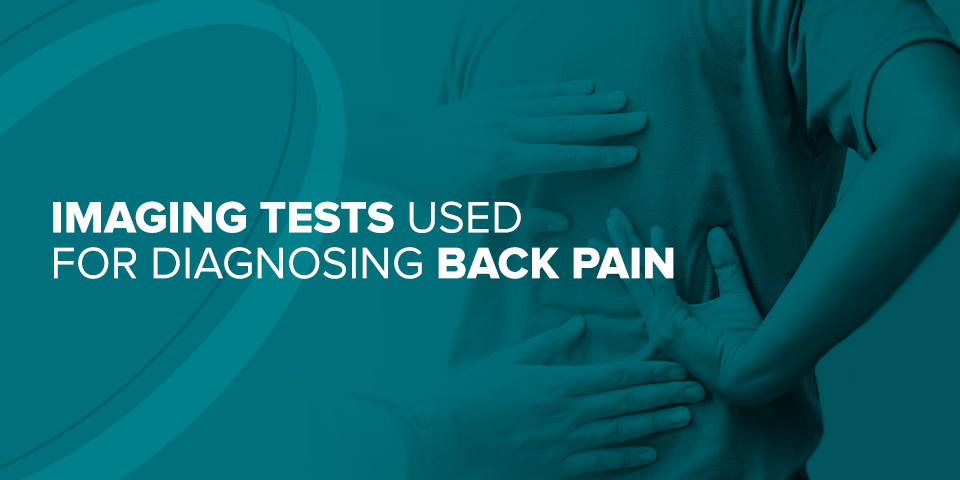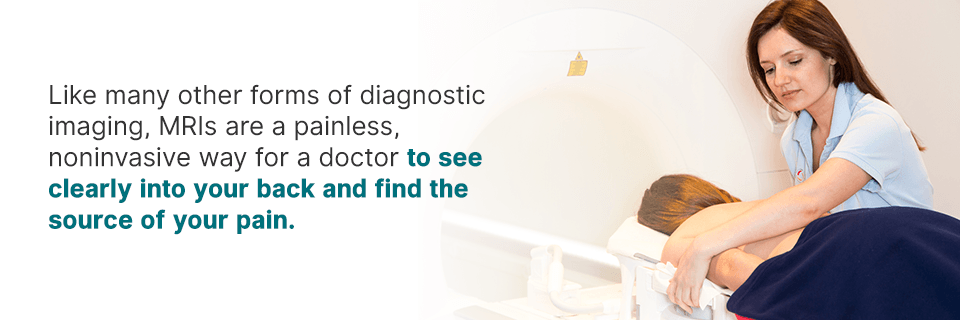Imaging Tests Used for Diagnosing Back Pain
Back pain is a common reason people miss work or visit their doctor. According to the National Institutes of Health (NIH), about 80% of adults suffer from lower back pain at one point or another. Back problems can make it difficult to enjoy life and carry out your regular daily activities. The good news is, most back pain is treatable without surgery, and medical professionals are here to help.
The first step to treating back pain is to find the cause. Your doctor may order an imaging test to determine the reason for your back discomfort. Tests such as x-rays, CT scans and MRIs allow a doctor to look into your back without performing surgery. Imaging tests are quick, painless procedures that provide valuable insight into your condition. We’ll look at the types of imaging tests commonly used to diagnose back pain, but first, it helps to understand what causes back discomfort. That way, you’ll know why your doctor ordered a specific test.
Common Causes of Back Pain
There are two types of back pain: acute and chronic. Acute back pain occurs suddenly and may last up to six weeks. Chronic back pain is less common and lasts longer than three months.
Many times, back pain begins without a known cause. An imaging test allows your doctor to find the cause of your pain, so that they can treat the issue effectively. Some possible common causes of back pain include:
- Muscle strains or ligament sprains: Strains and sprains are the most common causes of acute back pain. Both of these occur from picking up heavy objects, over-stretching or lifting something improperly. A strain or sprain can lead to painful spasms in the back.
- Disc degeneration: If you were to look between the vertebrae, or bones in your spine, you’d find rubbery discs. These intervertebral discs act as cushions to absorb shocks and help you bend your back. Over time, these discs can deteriorate and become more prone to rupturing or tearing. A bulging or ruptured disc might press on a nerve and cause back pain.
- Spinal stenosis: Spinal stenosis is the narrowing of the space around your spinal cord. This condition often affects the lower back and neck and may result in pain or numbness. It’s usually caused by spinal changes related to osteoarthritis.
- Skeletal irregularities: Skeletal irregularities such as scoliosis, which is the curvature of the spine, may cause back pain. However, scoliosis usually does not cause pain until middle age.
- Osteoporosis: Osteoporosis is a disease that causes bones to weaken. Individuals with osteoporosis are more vulnerable to experiencing fractures in their vertebrae.
- Traumatic injury: Playing sports, falling or being in a car accident may lead to injured muscles or ligaments in the back or a ruptured disc. Any of this could result in back pain.
Back pain is rarely a sign of a severe underlying condition, but it can be. A complete physical exam and imaging test for back pain will help your doctor pinpoint the cause so you can get the attention you need.
Types of Tests Used for Diagnosing Back Pain
Imaging tests create pictures of the inside of your body. They provide clues to help your doctor find out the source of your back irritation. Your doctor will select a test depending on your symptoms and the location of your back pain. Common types of scans used to diagnose back issues include the following.
1. X-Ray for Back Pain
An x-ray machine uses electromagnetic radiation to capture images of the inside of your body. Dense materials such as bones and metal appear white in an x-ray image, while muscles, fat and fluids appear dark. Your doctor may order an x-ray for back pain to check for the following:
- Fractured vertebrae
- Spinal changes due to osteoarthritis
- Spine alignment issues
X-rays are usually the first type of test a doctor will order to rule out bone injuries. Getting a back x-ray is a quick, painless and noninvasive procedure. Your doctor will need to perform a different imaging test if they suspect issues with the muscles, nerves or discs in your back.
If you get an x-ray for back pain at an Envision Imaging center, you can expect a specially trained technologist to perform the procedure as efficiently as possible and make sure you are comfortable throughout.
2. CT Scan for Back Pain
Your doctor might order a CT scan to diagnose a back injury related to soft tissues. A CT scan shows images of muscles, organs and ligaments more clearly than a conventional x-ray. CT scans are also often used in response to an emergency such as an accident or other trauma.
A CT scan machine produces multiple x-rays at different angles to create a detailed 3-D image of your bones and soft tissues. It can be an extremely useful diagnostic tool and helps prevent the need for exploratory surgery. A CT scan may be used to diagnose the following:
- Disc degeneration
- Ruptured discs
- Spinal stenosis
- Spinal cord infections or tumors
Today’s CT scanners are faster than ever and complete a scan within minutes. At an Envision Imaging location, you can expect state-of-the-art CT scan equipment and technologists who care about your comfort and safety.
3. MRI for Back Pain
MRIs use magnetic fields and radio waves to create highly detailed images of your spine, muscles, bones, organs and other tissues. A doctor might order an MRI for a back pain diagnosis if they suspect any of the following:
- Infection
- Tumor
- Disc rupture
Like many other forms of diagnostic imaging, MRIs are a painless, noninvasive way for a doctor to see clearly into your back and find the source of your pain. Some patients worry they will feel claustrophobic or anxious during an MRI. At Envision Imaging, we use the latest MRI technology, which is not as restricting as outdated equipment. In addition, our technologists are trained to help you relax and feel as comfortable as possible during the procedure.
MRI vs. X-Ray for Back Pain
An MRI and x-ray are both painless procedures and valuable diagnostic tools, and each one has benefits. For example, an MRI is a much better device for diagnosing soft tissue problems, and it does not expose patients to ionizing radiation. An x-ray mainly helps doctors identify bone issues and is a faster procedure than an MRI.
Your doctor will discuss the best imaging option for you as well as the risks and benefits.
CT Scan vs. MRI for Back Pain
Like x-rays, CT scans are usually quicker than MRIs. CT scans are the preferred tool for diagnosing severe injuries that need immediate attention, and they are also helpful in locating tumors. Typically, CT scans are better at scanning bone images than MRIs. However, they expose patients to a small dose of radiation, whereas MRIs do not. MRIs are ideal for diagnosing soft tissue and spinal ligament issues.
Schedule an Appointment Today
Back pain can cause great distress and take the joy out of life. At Envision Imaging, we understand how difficult it is to cope with back pain, and we want you to know you’re not alone. Our skilled and compassionate team is ready to help you find the source of your pain, so you can start the right treatment and move on with your life. Using world-class diagnostic tools, we aim to create a pleasant, convenient and affordable experience for our patients every time without sacrificing quality or accuracy. Browse our locations to request your next diagnostic imaging appointment. Our world-class facilities, compassionate care and accurate results ensure a pleasant and reliable experience.
Sources:
- https://www.mayoclinic.org/diseases-conditions/back-pain/symptoms-causes/syc-20369906
- https://www.ninds.nih.gov/Disorders/Patient-Caregiver-Education/Fact-Sheets/Low-Back-Pain-Fact-Sheet
- https://www.mayoclinic.org/diseases-conditions/herniated-disk/symptoms-causes/syc-20354095
- https://www.mayoclinic.org/diseases-conditions/spinal-stenosis/symptoms-causes/syc-20352961
- https://www.mayoclinic.org/diseases-conditions/osteoporosis/symptoms-causes/syc-20351968
- https://medlineplus.gov/diagnosticimaging.html
- https://www.envrad.com/services/x-ray/
- https://medlineplus.gov/xrays.html
- https://www.arthritis.org/about-arthritis/where-it-hurts/back-pain/diagnosis/back-pain-xray-mri-bonescan.php
- https://www.envrad.com/services/ct-scans/
- https://www.fda.gov/radiation-emitting-products/medical-imaging/medical-x-ray-imaging#benefits
- https://www.radiologyinfo.org/en/info.cfm?pg=safety-hiw_04
- https://www.envrad.com/services/mri-scans/
- https://www.envrad.com/difference-between-x-ray-ct-scan-and-mri/
- https://www.fda.gov/radiation-emitting-products/mri-magnetic-resonance-imaging/benefits-and-risks
- https://www.envrad.com/locations/





